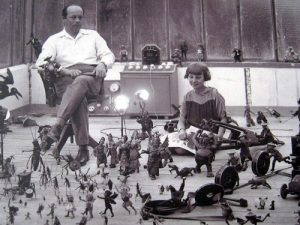Special program by Carlo Montanaro
THE PIONEER OF THREE-DIMENSIONAL ANIMATION: LADISLAS STAREWITCH (1882 – 1965)
 All started when a young entomologist tried to provide documentary evidence of the life of insects: to do so he turned to cinema, putting their life at risk due to the heat caised by the use of artificial light. He then realized that he could well re-create the life which had been destroyed. He managed to do this by using realistic puppets (marionettes in French) and the step-one technique. The result gives a sudden turn to Wladyslaw Sterewicz’s life (1882 – 1965), because it was then that he started in a, to assign human vices and virtues to insects first and animals later, always presenting the story under a fable-moralistic light. Russian born but of Polish ancestry, in the first decade of the century Starewicz directed several full-lenght films with living actors and enriched by special effects; after the Russian Revolution he moved to France with his family and was finally able to dedicate himself to three-dimensional animation. There are frequent works where the puppets interact with humans. He then changed his name into Vladislas Starewitch, and started to work supported by his wife but mostly bu his two daughters: Irina and, in particular Jennie, who became an actress known by the name of Nina Star.
All started when a young entomologist tried to provide documentary evidence of the life of insects: to do so he turned to cinema, putting their life at risk due to the heat caised by the use of artificial light. He then realized that he could well re-create the life which had been destroyed. He managed to do this by using realistic puppets (marionettes in French) and the step-one technique. The result gives a sudden turn to Wladyslaw Sterewicz’s life (1882 – 1965), because it was then that he started in a, to assign human vices and virtues to insects first and animals later, always presenting the story under a fable-moralistic light. Russian born but of Polish ancestry, in the first decade of the century Starewicz directed several full-lenght films with living actors and enriched by special effects; after the Russian Revolution he moved to France with his family and was finally able to dedicate himself to three-dimensional animation. There are frequent works where the puppets interact with humans. He then changed his name into Vladislas Starewitch, and started to work supported by his wife but mostly bu his two daughters: Irina and, in particular Jennie, who became an actress known by the name of Nina Star.
Great was the craftsmanship in creating the marionnettes, authentic wooden sculptures articulated and covered with chamois leather, adapted to anthropomorphic insects and animals, but also to caricatures of characters taken from reality. Curious and competent from a technical point of view, Starewitch systematically experimented the enrichments that cinema was acquiring at the time to enhance its spectacular potential. Thanks to this brief tribute we will be able to get to know three different stages of his career: the use of color applied (Pathecolor or pochoir), the sound, the realistic color. The programme will be enriched by some extra material from the DVDs published by Léona Béatrice, Martin-Starewitch and François Martin, who have been working for years to preserve his surviving original work, which is often presented on the occasion of exhibitions, such as the one presented at the 26th edition of “The Days of Silent Film” in Pordenone (2007). They do all this to make an inventory and restore what is left from the filmography of the pioneer of 3D animation, especially with reference to the period of his activity while he was in in France. This tribute has been made possible thanks to the collaboration and approval of Starewitch’s heirs.
Excerpts 1914 – 1920 – 2’50” – Three short extracts from three unfinished works dating to the period of silent cinema, with a Charlot-insect in action on a set…
La voix du rossignol – direction, subject, photography: L. Starewitch, interpreter: Nina Star – silent film – copy soaked and in Pathecolor (pochoir) – English version – France, 1923 – 13′ – The nightingale is not a toy. Captured, he is then set free by a little girl and to thank her for her kind action at dawn the nightingale sings for her.
Fetiche prestidigitateur – direction, subject, screenplay, photography: L. Starewitch – B/W – optical sound – France 1934 – 12′ – Fètiche is a cuddly dog that lives a series of adventures ascribable to the world of a little girl’s dream (Nina Star), which mostly take place in a circus, whose
Hypothesis of advertising – Attempt to advertise in Fetiche prestidigitateur – 24″
How a marionette is born and enlivened I – 3’15” – B/W – spoken – II – 1′ 37″ – B/W – In these two short inserts of the 30’s Starewitch tells about his brilliant and painstaking work.
Carrousel boreal – screenplay, character animation L. and I. Starewitch – music Daniel White – art direction (and production): Alexandre Kamenka – color – France – 1958 – 12′ – Three anthropomorphic puppets (a little bear, a rabbit and a dog), survive the snow and ice and enjoy the thaw with the awakening of nature. About 43′.
